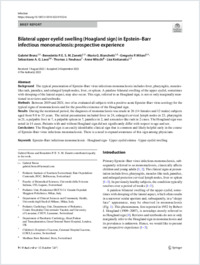Bilateral upper eyelid swelling (Hoagland sign) in Epstein–Barr infectious mononucleosis : prospective experience
- Bronz, Gabriel Pediatric Institute of Southern Switzerland, Ente Ospedaliero Cantonale, EOC, Bellinzona, Switzerland ; Faculty of Biomedical Sciences, Università della Svizzera italiana, Switzerland
- Zanetti, Benedetto P. E. S. M. Pediatric Institute of Southern Switzerland, Ente Ospedaliero Cantonale, EOC, Bellinzona, Switzerland ; Faculty of Biomedical Sciences, Università della Svizzera italiana, Switzerland
- Bianchetti, Mario G. Pediatric Institute of Southern Switzerland, Ente Ospedaliero Cantonale, EOC, Bellinzona, Switzerland ; Faculty of Biomedical Sciences, Università della Svizzera italiana, Switzerland
- Milani, Gregorio P. Pediatric Unit, Fondazione IRCCS Ca’ Granda Ospedale Maggiore Policlinico, Milan, Italy ; Department of Clinical Sciences and Community Health, Università degli Studi di Milano, Milan, Italy
- Lava, Sebastiano A. G. Pediatric Cardiology Unit, Department of Pediatrics, Centre Hospitalier Universitaire Vaudois and University of Lausanne, CHUV, Lausanne, Switzerland ; Department of Paediatric Cardiology, Heart Failure and Transplantation, Great Ormond Street Hospital, London, UK
- Neuhaus, Thomas J. Children’s Hospital of Lucerne, Cantonal Hospital Lucerne, LUKS, Lucerne, Switzerland
- Witschi, Anne Medbase Bern Bahnhof, Bern, Switzerland
- Kottanattu, Lisa Pediatric Institute of Southern Switzerland, Ente Ospedaliero Cantonale, EOC, Bellinzona, Switzerland ; Faculty of Biomedical Sciences, Università della Svizzera italiana, Switzerland
- 2022
Published in:
- Infection . - 2022, vol. 51, p. 471–474
English
Background: The typical presentation of Epstein–Barr virus infectious mononucleosis includes fever, pharyngitis, measleslike rash, jaundice, and enlarged lymph nodes, liver, or spleen. A painless bilateral swelling of the upper eyelid, sometimes with drooping of the lateral aspect, may also occur. This sign, referred to as Hoagland sign, is not or only marginally mentioned in reviews and textbooks. Methods: Between 2019 and 2021, two of us evaluated all subjects with a positive acute Epstein–Barr virus serology for the typical signs of mononucleosis and for the possible existence of the Hoagland sign. Results: During the mentioned period, the diagnosis of mononucleosis was made in 26 (14 females and 12 males) subjects aged from 9.0 to 33 years. The initial presentation included fever in 24, enlarged cervical lymph nodes in 23, pharyngitis in 21, a palpable liver in 7, a palpable spleen in 7, jaundice in 2, and a measles-like rash in 2 cases. The Hoagland sign was noted in 14 cases. Patients with and without Hoagland sign did not significantly differ with respect to age and sex. Conclusions: The Hoagland sign is an easily identifiable clinical sign that is common and likely helpful early in the course of Epstein–Barr virus infectious mononucleosis. There is a need to expand awareness of this sign among physicians.
- Collections
- Language
-
- English
- Classification
- Medicine
- License
- Open access status
- hybrid
- Identifiers
-
- DOI 10.1007/s15010-022-01932-6
- ARK ark:/12658/srd1325744
- Persistent URL
- https://n2t.net/ark:/12658/srd1325744
Statistics
Document views: 127
File downloads:
- Bronz_2022_Spri_Infection: 160
